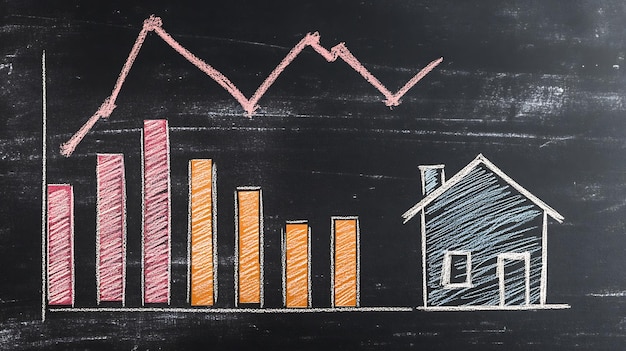Is It Time to Refinance Your Mortgage? Rates & Savings in 2025

Refinancing your mortgage in 2025 could lead to significant savings if current interest rates are lower than your existing mortgage rate, but a comprehensive analysis of your financial situation, including closing costs and long-term goals, is crucial before making a decision.
Are you pondering the question, is now the time to refinance your mortgage? Analyze current rates and save thousands in 2025? Homeowners frequently explore refinancing to secure better interest rates, shorten their loan term, or tap into their home equity. Understanding the current market conditions and your personal financial situation is essential to determining if refinancing is the right move for you.
Understanding Mortgage Refinancing
Mortgage refinancing involves replacing your existing mortgage with a new one, ideally with more favorable terms. This can translate to lower monthly payments, reduced interest costs over the life of the loan, or access to cash for other financial needs. However, it’s crucial to weigh the potential benefits against the costs, like application fees and closing costs, to ensure refinancing aligns with your long-term financial goals.
Refinancing isn’t a one-size-fits-all solution. Its suitability depends on various factors, including your current mortgage rate, the prevailing interest rates, your credit score, and the amount of equity you have in your home.

Types of Mortgage Refinancing Options
Understanding the different types of refinancing options is crucial for making an informed decision. Each type caters to specific financial goals and situations.
- Rate and Term Refinance: This involves getting a new mortgage with a lower interest rate or a different loan term, aiming to reduce monthly payments or shorten the repayment period.
- Cash-Out Refinance: This type allows you to borrow more than your existing mortgage balance and receive the difference in cash. This can be used for home improvements, debt consolidation, or other significant expenses.
- Cash-In Refinance: In this scenario, you pay down your mortgage balance to increase your equity, potentially removing the need for private mortgage insurance (PMI).
Choosing the right type depends on your individual circumstances and what you hope to achieve through refinancing.
In conclusion, understanding mortgage refinancing involves recognizing its potential benefits and drawbacks, considering various factors, and choosing the option that aligns with your financial objectives.
Analyzing Current Mortgage Rates
Keeping a close eye on current mortgage rates is essential when considering refinancing. Mortgage rates are dynamic and influenced by various economic factors, including inflation, the Federal Reserve’s policies, and the overall health of the economy. Understanding these factors can help you anticipate rate movements and time your refinance application strategically.
Comparing rates from different lenders can also lead to significant savings over the long term.
Factors Influencing Mortgage Rates
Several key factors shape mortgage rates. Understanding these influences provides valuable context for interpreting rate trends.
- Economic Growth: A strong economy typically leads to higher interest rates, while a slowing economy may result in lower rates.
- Inflation: Rising inflation often pushes interest rates upward as lenders seek to maintain their returns.
- Federal Reserve Policy: The Federal Reserve’s decisions regarding the federal funds rate can significantly impact mortgage rates.
Staying informed about these factors enables you to make more informed decisions about when to refinance.

In summary, analyzing current mortgage rates involves monitoring economic indicators, comparing rates from various lenders, and being aware of the factors that influence rate movements.
Calculating Potential Savings
One of the primary reasons homeowners consider refinancing is the potential for significant savings. Calculating these potential savings involves comparing your current mortgage terms with the terms of a new mortgage. This includes comparing interest rates, loan terms, and associated fees. Online mortgage calculators can be valuable tools in this process, allowing you to estimate potential savings based on different scenarios.
Remember to consider the long-term implications of refinancing, as the overall savings can vary depending on how long you plan to stay in your home.
Using a Mortgage Refinance Calculator
Mortgage refinance calculators are readily available online and can help you estimate your potential savings quickly and easily. Here’s how to use them effectively:
- Enter your current mortgage details, including the outstanding balance, interest rate, and remaining loan term.
- Input the details of the new mortgage you’re considering, such as the new interest rate, loan term, and any associated fees.
- The calculator will then estimate your new monthly payment, total interest paid over the life of the loan, and overall savings.
Use these calculators to explore different scenarios and understand how changes in interest rates or loan terms can impact your savings.
In conclusion, calculating potential savings is a critical step in determining if refinancing is right for you. Use online calculators and consider long-term implications to make an informed decision.
Assessing Your Financial Situation
Before you refinance your mortgage, it’s crucial to take a close look at your current financial situation. Lenders will evaluate your credit score, debt-to-income ratio, and employment history to determine your eligibility for a new loan. Improving your credit score and reducing your debt can significantly increase your chances of securing a favorable refinance rate. Be prepared to provide documentation such as pay stubs, tax returns, and bank statements.
Remember that refinancing involves costs, and it’s essential to ensure that the long-term benefits outweigh these initial expenses.
Key Factors Lenders Consider
Lenders assess your financial situation based on several key factors. Understanding these criteria can help you prepare your application effectively.
- Credit Score: A higher credit score demonstrates your creditworthiness and can help you qualify for lower interest rates.
- Debt-to-Income Ratio (DTI): Lenders assess your DTI to determine how much of your monthly income goes towards debt payments. A lower DTI indicates that you have more disposable income and are less risky to lend to.
- Employment History: Lenders prefer stable employment history as it provides assurance that you have a reliable source of income.
Addressing any weaknesses in these areas can improve your chances of approval and secure more favorable terms.
In summary, assessing your financial situation involves evaluating your credit score, debt-to-income ratio, and employment history. Addressing any financial issues before applying can increase your likelihood of approval and favorable terms.
Understanding Refinancing Costs and Break-Even Point
Refinancing is not free. Closing costs can include application fees, appraisal fees, title insurance, and other expenses that can add up. Understanding these costs is essential for determining whether refinancing makes financial sense. The break-even point is the amount of time it takes for your savings from lower monthly payments to offset the refinancing costs. Calculate the break-even point before refinancing to ensure that the long-term savings justify the upfront expenses.
Keep in mind that the longer you plan to stay in your home, the more worthwhile refinancing becomes.
Calculating Your Break-Even Point
Calculating your break-even point helps you determine when the savings from refinancing will outweigh the associated costs. Here’s how to do it:
- Determine the total refinancing costs, including all fees and expenses.
- Calculate the difference between your current monthly mortgage payment and the new, lower monthly payment.
- Divide the total refinancing costs by the monthly savings to find the number of months it will take to break even.
If you plan to stay in your home longer than the break-even point, refinancing is likely a worthwhile investment.
In conclusion, understanding refinancing costs and calculating the break-even point ensures that you make a financially sound decision. Consider the length of time you plan to stay in your home when evaluating the potential benefits.
Making the Decision: Is Refinancing Right for You in 2025?
Deciding whether to refinance your mortgage is a personal decision that depends on your unique financial circumstances and goals. Is now the time to refinance your mortgage? Analyze current rates and save thousands in 2025 requires carefully considering factors such as current interest rates, your credit score, and your long-term financial plans. If you can secure a lower interest rate, reduce your monthly payments, or shorten your loan term without incurring excessive costs, refinancing may be a smart move. However, if the costs outweigh the benefits or if you plan to move in the near future, it may be best to postpone refinancing.
Seeking advice from a financial advisor or mortgage professional can offer valuable insights tailored to your specific situation.
Questions to Ask Yourself Before Refinancing
Before making a final decision, ask yourself these key questions to ensure refinancing aligns with your financial goals:
- What are my long-term financial goals, and how does refinancing fit into them?
- How long do I plan to stay in my home?
- Can I comfortably afford the refinancing costs, and how long will it take to break even?
- Are there any potential downsides to refinancing, such as prepayment penalties or changes to my loan terms?
Answering these questions honestly will empower you to make an informed and confident decision.
| Key Point | Brief Description |
|---|---|
| 💰 Lower Interest Rates | Refinancing can secure a lower interest rate, reducing monthly payments and overall interest paid. |
| 📊 Financial Assessment | Evaluate your credit score and debt-to-income ratio before applying to improve your chances. |
| ⏱️ Break-Even Point | Calculate the time it takes for savings to offset costs, ensuring long-term benefit. |
| 🏡 Long-Term Goals | Assess how refinancing aligns with your financial objectives, like staying in your home longer. |
FAQ
Mortgage refinancing is replacing your existing mortgage with a new one, often to secure a lower interest rate or change the loan term.
Compare your current mortgage terms with the new ones, including interest rates, fees, and loan terms. Use online calculators for estimates.
Economic growth, inflation, and Federal Reserve policies significantly impact mortgage rates, so it’s important to stay informed about these factors.
The break-even point is the time it takes for savings from lower monthly payments to offset initial refinancing costs. Calculate this before proceeding.
Assess long-term financial goals, credit score, debt-to-income ratio, employment history, and how long you plan to stay in your home.
Conclusion
In conclusion, deciding if now is the right time to refinance your mortgage requires a thorough assessment of your financial situation, current market conditions, and long-term financial goals. By carefully analyzing these factors and seeking professional advice, you can make an informed decision that aligns with your needs and helps you achieve your financial objectives in 2025 and beyond.





